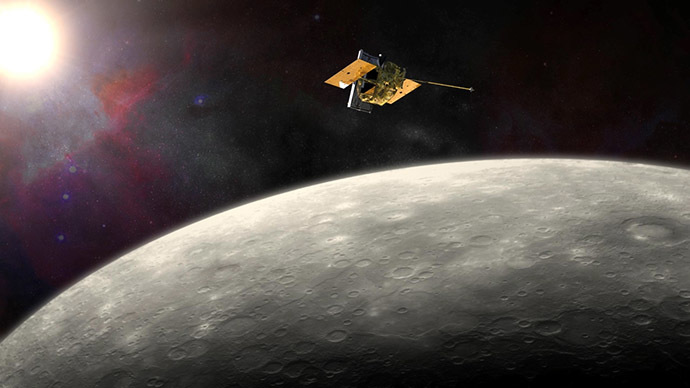Crash and burn: Mercury probe to end mission with planetary collision

A probe orbiting the solar system’s innermost planet is set to end its mission with a bang, leaving a mark on the surface of Mercury to be used by follow-up missions. The MESSENGER spacecraft should collide with the planet at the end of April.
The 10-foot probe is scheduled to adjust its orbit on April 24 and impact the planetary surface on April 30. According to mission systems engineer Daniel O'Shaughnessy of John Hopkins University's Applied Physics Lab, the probe should hit the planet at a speed of 8,750 mph and leave a crater measuring approximately 52 feet across.
Mercury Probe's Dramatic Death Plunge Set for April 30 http://t.co/6wGjwOiqiE
— SPACE.com (@SPACEdotcom) April 16, 2015
“After studying the planet intently for more than four years, Messenger's final act will be to leave an indelible mark on Mercury,” O'Shaughnessy said at a news conference Thursday. “That impact will not be in view," he added. “It will happen during a planetary occultation, so the spacecraft will pass behind the planet, out of view of the Earth, and will just not emerge again.”
Though the impact crater won’t be visible from the Earth, scientists hope that the joint European-Japanese BepiColombo mission, due to launch in 2017 and arrive in orbit around Mercury in 2024, will be able to investigate the crash site.
“Having an impact crater, even a small one, whose origin date is precisely known, will be an important benchmark,” Sean Solomon, the mission's principal investigator and director of Columbia University's Lamont-Doherty Earth Observatory, told Space.com.
READ MORE: Earth ‘swallowed Mercury-like planet’ to form layers and magnetic field – Oxford study
Launched in 2004, the $450 million “Mercury Surface, Space Environment, Geochemistry and Ranging” vessel (MESSENGER) arrived in the planet’s orbit in March 2011. It was the only probe ever to orbit Mercury and the second spacecraft to study Mercury up close, after NASA’s Mariner 10 flew by the planet three times in the 1970s.
During its four-year mission, the probe completed over 4,100 orbits around the planet and relayed a wealth of information about Mercury. One of the major discoveries was finding organic compounds and water ice inside the shaded crater rims near the planet’s poles. MESSENGER also confirmed that Mercury does rotate, though very slowly: one ‘day’ on Mercury is two planetary years long.
LIVE Now: Our @MESSENGER2011 end of mission celebration. #askNASA about planet Mercury! Watch: http://t.co/KX5g7yYnYGpic.twitter.com/4wy3FkDSBq
— NASA (@NASA) April 16, 2015
NASA celebrated the end of the mission on Thursday. “We are celebrating MESSENGER as more than a successful mission," John Grunsfeld, an administrator for NASA's Science Mission Directorate, said in a statement. “It's the beginning of a longer journey to analyze the data that reveals all the scientific mysteries of Mercury.”












